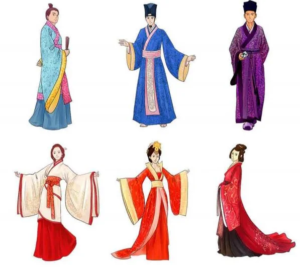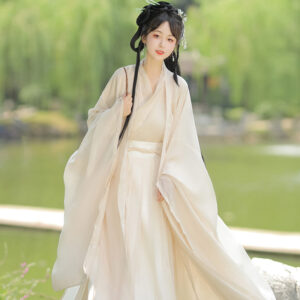

The Qing Dynasty (1644-1912) marked a significant transformation in Hanfu, reflecting both the political dominance of the Manchu rulers and the cultural exchanges that occurred during this period. Here are the key changes in Hanfu style during the Qing Dynasty:
1. Manchu Influence
- Introduction of Manchu Styles: The Qing rulers, being Manchu, introduced their distinct sartorial elements into traditional Hanfu. This led to the emergence of garments like the Qipao (Cheongsam) for women and Changshan for men, characterized by straight cuts, high collars, and narrow sleeves. These styles contrasted sharply with the flowing robes typical of earlier Hanfu designs.
- Cultural Assertion: The adoption of Manchu clothing styles was not merely a fashion evolution but also a means for the Manchu to assert their cultural identity and political dominance over the Han Chinese population.
2. Queue Edict
- Regulatory Changes: The Queue Edict mandated that all Han men adopt the Manchu hairstyle, which involved shaving the front part of the head and growing a long braid (queue). This hairstyle became a potent symbol of submission to Qing rule and influenced clothing choices, particularly headwear.
- Symbol of Identity: The queue hairstyle was not just a personal choice; it represented allegiance to the ruling dynasty and became a significant cultural marker during this period.
3. Shift in Silhouette and Structure
- Narrower Silhouettes: The traditional Hanfu’s wide sleeves and flowing silhouette evolved into more structured forms. The Qipao, for instance, became a body-fitting dress that highlighted feminine curves, moving away from the looser styles of previous dynasties.
- Simplification of Designs: Many Hanfu garments adopted simpler designs with less emphasis on elaborate layers, reflecting a shift toward practicality in everyday wear.
4. Integration of Ethnic Styles
- Cultural Fusion: The Qing Dynasty was characterized by its vast territory and diverse ethnic groups. This diversity led to an integration of various regional styles into Hanfu. For example, local customs influenced fabric choices and designs, resulting in garments that incorporated unique elements from different cultures.
- Regional Variations: In colder regions, thicker fabrics and layered garments became common, while southern styles favored lighter materials suited for warmer climates. This adaptation showcased the empire’s rich cultural landscape.
5. Imperial Regulations
- Sumptuary Laws: The Qing government established strict dress codes based on social rank and ethnicity. These regulations dictated what colors, fabrics, and designs could be worn by different classes, reinforcing social hierarchies.
- Symbolic Motifs: Certain motifs were reserved for specific ranks; for instance, only the emperor could wear garments adorned with dragon motifs. Such regulations emphasized the political control exerted by the Manchu rulers over the Han population.
6. Decline of Traditional Hanfu
- Shift Away from Hanfu: As Manchu styles gained prominence, traditional Hanfu gradually fell out of favor among many segments of society. By the late Qing Dynasty, Western influences began to emerge, further contributing to this decline.
- Modern Adaptations: While traditional Hanfu styles were largely replaced in everyday life by Western-style clothing in the early 20th century, there has been a modern revival of interest in Hanfu as a symbol of cultural heritage in recent years.
Summary Table: Key Changes in Hanfu During the Qing Dynasty
| Aspect | Description |
|---|---|
| Manchu Influence | Introduction of straight cuts and high collars; emergence of Qipao and Changshan |
| Queue Edict | Mandated hairstyle symbolizing submission; influenced headwear choices |
| Silhouette Shift | Transition to narrower silhouettes; simplification of designs |
| Integration of Ethnic Styles | Fusion of regional styles; adaptations based on local customs |
| Imperial Regulations | Strict dress codes reinforcing social hierarchy; exclusive motifs for certain ranks |
| Decline of Traditional Hanfu | Traditional styles fell out of favor; emergence of Western influences |
Conclusion
The changes in Hanfu style during the Qing Dynasty reflect a complex interplay between cultural adaptation and political dominance. The integration of Manchu elements into traditional attire not only transformed fashion but also served as a medium for asserting authority over the Han Chinese populace. This era illustrates how clothing can embody broader socio-political dynamics while also adapting to diverse cultural influences within an expansive empire.
Share this post
Recent Posts


What were the key features of Hanfu during the Tang Dynasty?

How did Hanfu styles vary during different Chinese dynasties?

What accessories are typically worn with Hanfu?

How do you choose the right Hanfu for different seasons?

Newsletter
Popular Categories
Related Post
Sed aliquam, tortor et sodales malesuada, lorem leo luctus tellus, quis interdum eros nibh in nunc. Cras dignissim malesuada, lorem leo luctus

What are the winter hanfu called?

What were the key features of Hanfu during the Tang Dynasty?

How did Hanfu styles vary during different Chinese dynasties?


